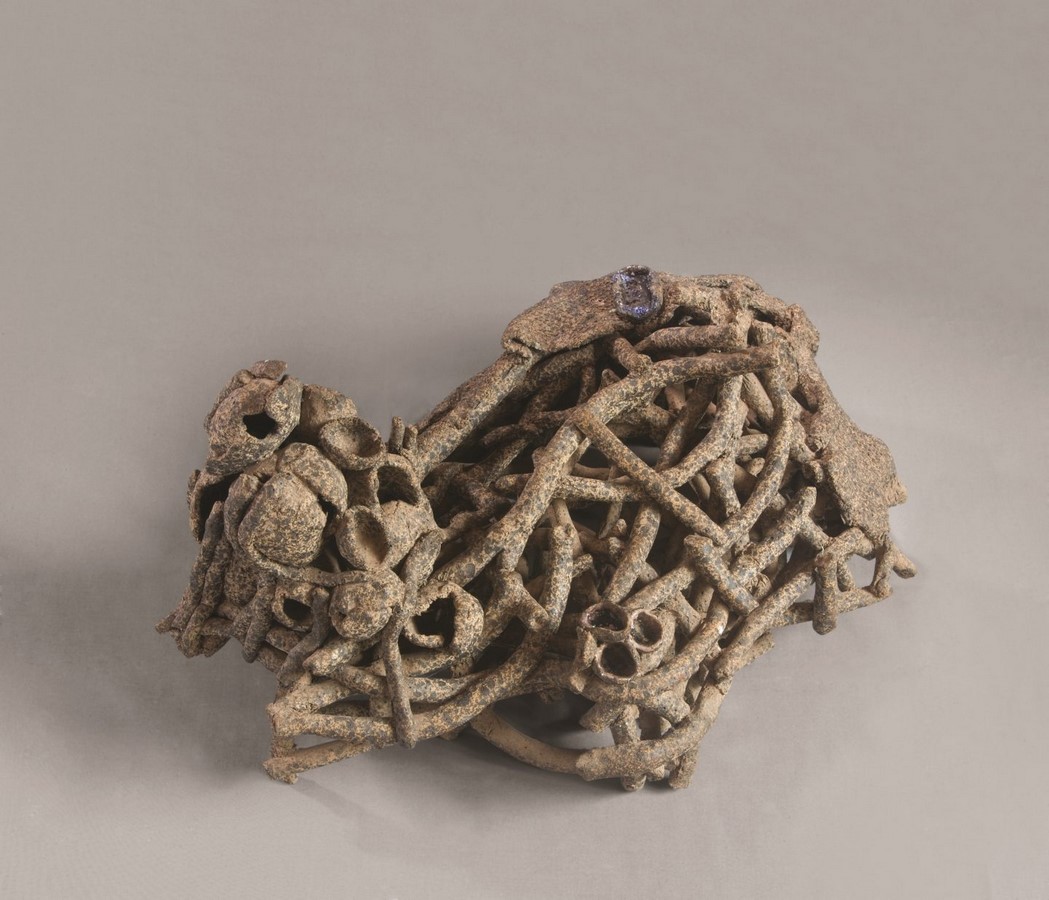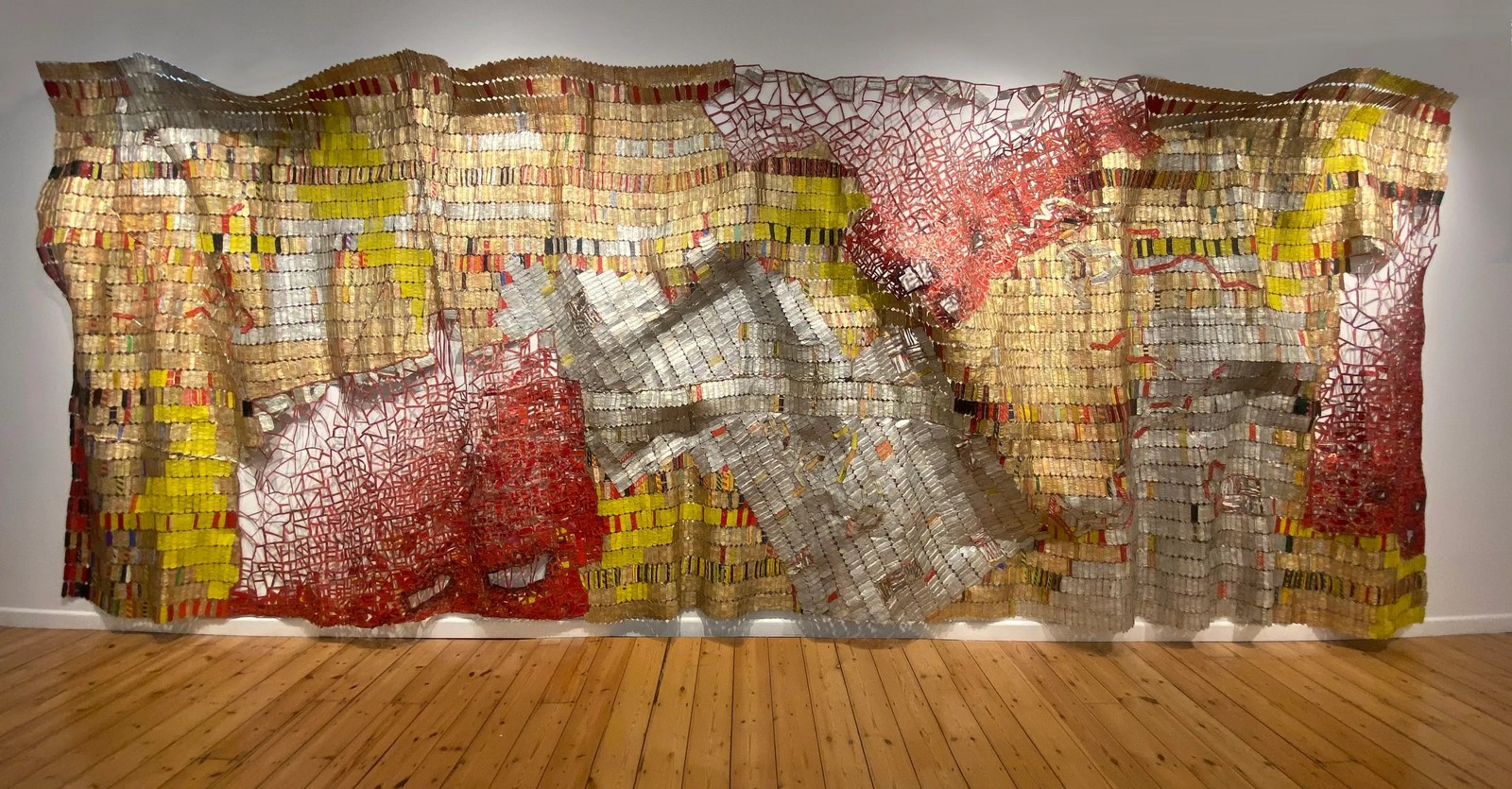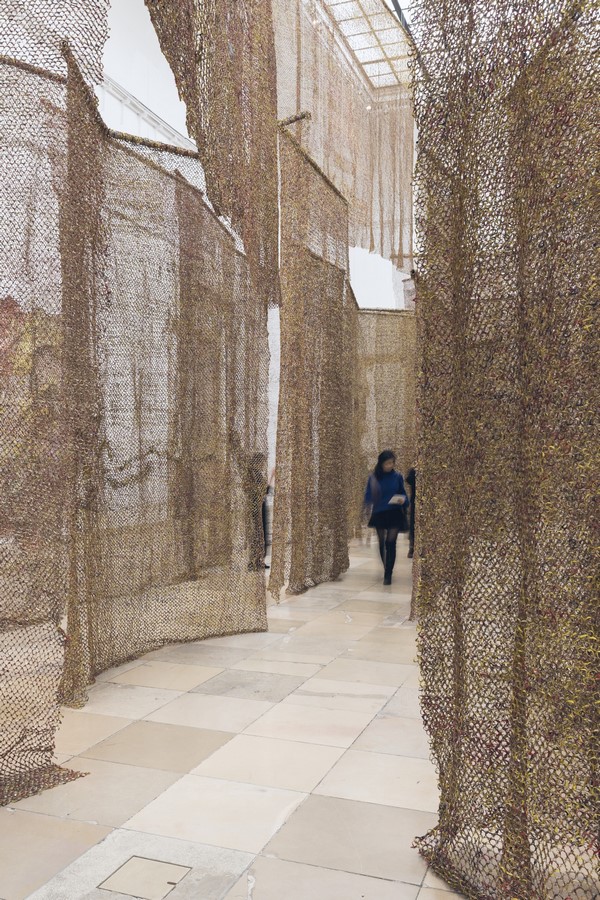“… When I create work… it is in my view a metaphor reflecting an alternative response to examine … possibilities and extend the boundaries in art. … My work can represent links in the evolving narrative of memory and identity.” (El Anatsui)
At the forefront of Ghanaian art, as well as African art and contemporary art in general, El Anatsui’s work is a multidimensional exploration of ideology, materiality, globalism, and artistic mastery. Born in Anyako, Ghana in 1944, El Anatsui received his BA from the College of Art, University of Science and Technology, in Kumasi, Ghana in 1969. He has an exceptionally established dual career as both an artist, as well as a professor, and since 1975 has taught at the University of Nigeria. He has also resided in Nigeria since, where he continues with his artistic endeavors. In terms of directionality, Anatsui has a particular interest in African craft, as reflected through his work, which “led him to be associated with the 1970s art movement Nsukka group” (Tate).

Anatsui pays homage to the everyday through his unique installations. The artist transfigures everyday objects into grand totems. His assemblages include a variety of mixed media and materials: bottle caps, copper wiring, sheet metal, wood, and clay, among many others. His sculptures extend to both a floor-based horizontality, and a hung verticality, depending on the piece and intent. Despite the opaque rigidity of Anatsui’s materials, his work is exceptionally flexible, in which the pieces warp like malleable cloth. This allows for a unique personalization for each installation. During Anatsui’s early years at the University of Nigeria, he worked on his “Broken Pots” series: he shattered potsherds, and then partially joined them together to create a series of ceramic sculptures. In their essence of destruction, Anatsui aimed to portray the death and transmutation of the African continent by external colonial and postcolonial forces, and, through the fusing of the pieces back together, he suggested a contemporary reconstruction of the continent.

In the early 21st century, the nature and subject matter of Anatsui’s work shifted dramatically: he began producing metal tapestries made of aluminum bottle caps. According to Anatsui, the bottle caps served a deeper commentary- essentially a reflection of colonialism’s destructive forces, as well as the resilience of Africa: “Alcohol was one of the commodities brought with [Europeans] to exchange for goods in Africa. Eventually alcohol became one of the items used in the transatlantic slave trade…” (Britannica). Eventually, after much cutting, stitching, pounding, and folding, Anatsui was successful in creating an assemblage from the aluminum bottle caps, forming a malleable, glittering cloth. The process of his large-scale aluminum bottle assemblages has also been likened to the making of “Kente” cloth, a traditional practice of the Asante people- once again, reflective of a holistic artist whose lifelong oeuvre was linked to Africa.
The transmutability of his work may be considered his defining characteristic: he breaks free from the traditional respect for fixed shapes in sculpture, instead, opting to produce free and flexible assemblages instead, “visually referencing the history of abstraction in African and European art” (art21). Beyond the surface of the artistic inclinations of the pieces, Anatsui’s work also has a secondary layer of analysis. The artist explores the long-standing effects of human consumption- most notably that of the everyday object. The everyday object is thus, viewed under a new lens in a criticism of its metamorphic lifecycle- production, value, exchange, destruction, and transmutation.

Anatsui’s work is multidimensional in its numerous artistic, sociocultural, and political perspectives. One on hand, Anatsui essentially defies the notion and form of the traditional sculptural installation. The flexibility of his work defines his assemblages, whether free-standing or hung. His choice is materials is also one that is worth noting: its criticism of human consumption is particularly evident. His interest in traditional African techniques in art is also one that is of a two-fold nature; on the one hand, he contributes to a long-lasting theme of artistic preservation of vernacular and local processes, and, on the other, his work raises questions on ethnic identity- particularly African. Furthermore, his work may be seen as a larger critique of “ideological relations” (artsy) between The West and The Global South in terms of resource allocation, international relations, and power dynamics: referencing his aluminum bottle cap series, “The colorful and densely patterned fields of the works assembled from discarded liquor-bottle caps also trace a broader story of colonial and postcolonial economic and cultural exchange in Africa, told in the history of cast-off materials” (art21). A criticism of the destructive forces of post-colonialism and late-stage capitalism- not mutually exclusive themes.
Anatsui is an exceptionally renowned artist: his works are in public collections of major museums, such as the Metropolitan Museum of Art, Museum of Modern Art, British Museum, and Centre Pompidou, Paris, among many others. He has also participated in the Venice Biennale twice, once in 1990, and once in 2007. In 2011, retired from his teaching post at UNN, where he had been since 1975. He remained in his studio in Nsukka but also opened working spaces in Enugu, Nigeria, and Tema, Ghana. He continuously and constantly experiments and expands on his later work of metal tapestries. Once again, to reiterate, Anatsui’s work is a continuous lifelong reflection on the African condition- whether from a global, political, sociocultural, or artistic lens, and his art is often an agglomeration of all four. Placed under the spotlight, Anatsui represents a lifelong passion for manipulating subject matter into a new form of art that simultaneously aims to educate and commentate.
Refrences:
El Anatsui. Available at: https://elanatsui.art/ (Accessed: 29 September 2023).
El Anatsui. Art21. Available at: https://art21.org/artist/el-anatsui/ (Accessed: 29 September 2023).
El Anatsui – biography, shows, Articles & More (no date) Artsy. Available at: https://www.artsy.net/artist/el-anatsui (Accessed: 29 September 2023).
El Anatsui. Encyclopædia Britannica. Available at: https://www.britannica.com/biography/El-Anatsui (Accessed: 29 September 2023).
Who is El Anatsui? | Tate. Available at: https://www.tate.org.uk/art/artists/el-anatsui-17306/who-is-el-anatsui (Accessed: 29 September 2023).














